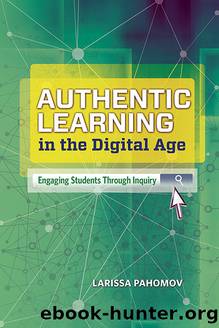Authentic Learning in the Digital Age by Larissa Pahomov

Author:Larissa Pahomov [Pahomov, Larissa]
Language: eng
Format: epub
Tags: Education
ISBN: 978-1-4166-1959-8
Publisher: ASCD
Published: 2014-11-01T00:00:00+00:00
Interactive
The last flaw with traditional presentation is its static format. In many real-world situations, the stakes of a live speech are high because the goal of the speaker is to influence peopleâto get them to vote, to laugh, to buy. In the typical classroom, however, the only parties who really "care" about the presentation are the presenter and the teacher. Sometimes students have an authentic interest in the content, but more frequently they are preoccupied with the logistics of the assessment, either nervously awaiting their turn or tuned out because they already went. When it's time for questions, an awkward silence ensues, and then eventually the teacher poses questions that help determine a grade.
Teachers may gripe about the lack of engagement during class presentations, but students are not the ones who created this culture. If students are typically creating work that only the teacher sees and never receive feedback from anybody else, why should they suddenly care what their peers think? And why should they give attention to others when that effort on their part is not valued?
For students to care about each other's presentations, they must have a vested interest in the work. Ideally they already have some intrinsic interest in the content, but they can also benefit from a presentation structure in which some kind of interaction is integral to the project's success. This goal can be achieved in a number of ways. One is to allow for interaction before the teacher is making the final assessment, so that students can help improve each other's work. SLA math teacher Caitlin Thompson uses this strategy with her Algebra 1 students when they complete a project on systems of inequalities. Students dream up a snack that uses two ingredients and then must create a formula that allows them to determine "the most profitable and desirable combination" for that product. Once all the calculations are complete, Thompson gives each group 20 minutes to produce three slides on their project, and then devotes one class period for students to present and reflect on each other's work.
Commenting on her recent experience with this strategy, Thompson says it gave her "a quick chance to review how well students were doing in general on the topic. It was very interesting to see who caught other students' mistakes more quickly and who caught their own mistakes as they were presenting." Students valued the presentations because they were able to give meaningful feedback to each other based on their own proficiency. Thompson was so impressed with their proofreading the first time she did this project that she now schedules presentations to take place before students turn in the project for gradingâa kind of live rough draft in which the student feedback helps improve the final product.
Another method to encourage interaction is to give students a role in the assessment itself. The simplest way to do this is to have students fill out the grading rubric with comments for their peers as they view the presentations. Teachers can
Download
This site does not store any files on its server. We only index and link to content provided by other sites. Please contact the content providers to delete copyright contents if any and email us, we'll remove relevant links or contents immediately.
Navigation and Map Reading by K Andrew(4892)
Spare by Prince Harry The Duke of Sussex(4792)
Tuesdays with Morrie by Mitch Albom(4411)
Cracking the GRE Premium Edition with 6 Practice Tests, 2015 (Graduate School Test Preparation) by Princeton Review(4052)
Machine Learning at Scale with H2O by Gregory Keys | David Whiting(3647)
What It Really Takes to Get Into Ivy League and Other Highly Selective Colleges by Hughes Chuck(3559)
Never by Ken Follett(3537)
Goodbye Paradise(3455)
Harry Potter and the Prisoner of Azkaban (Book 3) by J. K. Rowling(3116)
Pledged by Alexandra Robbins(3050)
Kick Ass in College: Highest Rated "How to Study in College" Book | 77 Ninja Study Skills Tips and Career Strategies | Motivational for College Students: A Guerrilla Guide to College Success by Fox Gunnar(3002)
Fairy Tale by Stephen King(2956)
A Dictionary of Sociology by Unknown(2858)
Sapiens and Homo Deus by Yuval Noah Harari(2849)
Reminders of Him: A Novel by Colleen Hoover(2772)
The Social Psychology of Inequality by Unknown(2770)
Graduate Admissions Essays, Fourth Edition: Write Your Way into the Graduate School of Your Choice (Graduate Admissions Essays: Write Your Way Into the) by Asher Donald(2739)
Get into Any College by Tanabe Gen Tanabe Kelly(2633)
Zero to Make by David Lang(2630)
